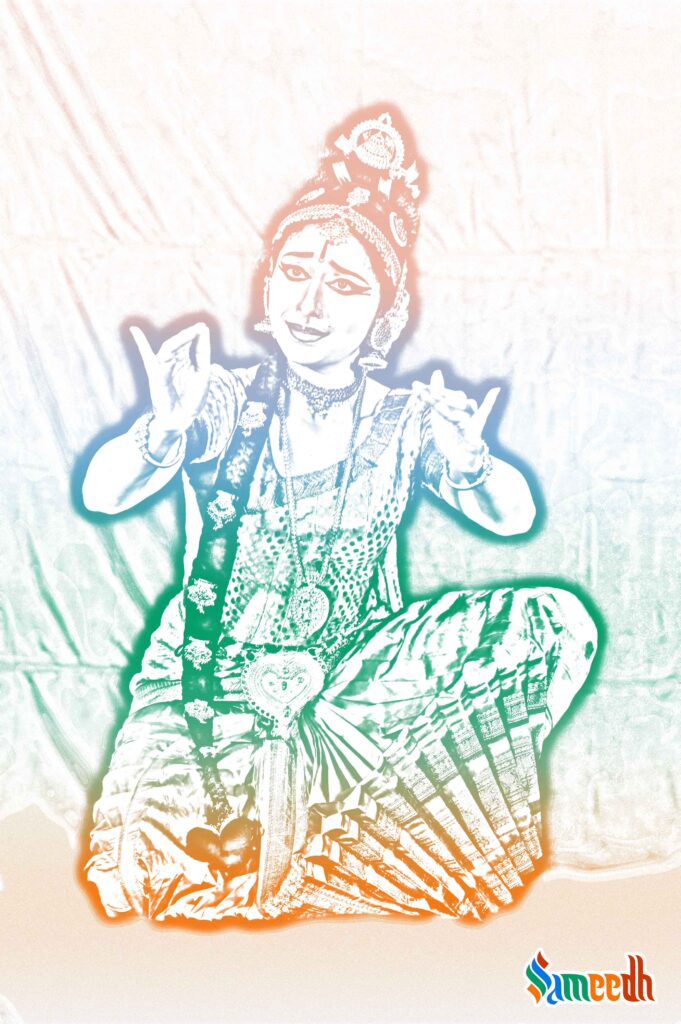Kuchipudi an ancient Indian dance form, originated in Andhra Pradesh. This classical dance was popularised by the backing of the Brahmins who practised it.

A dancer in a costume, an expressive part of a Kuchipudi performance; Image Source: Mullookkaaran
Kuchipudi is a well-known classical dance form of India that developed in a village in Andhra Pradesh. It is one of the top 8 classical dance styles in India. Kuchipudi is a dance-drama theatrical art. Similar to all other prominent Indian classical dance styles, Kuchipudi also developed as a religious art with origins in the ancient Hindu Sanskrit literature ‘Natya Shastra’ and has cultural connections to temples, religious institutions, and touring groups.
SIGNIFICANCE
Kuchipudi emerges as one of Andhra Pradesh’s most significant contributions to Indian art. The famous dance-drama has added to the rich tradition of performing arts in India and is officially acknowledged as one of the eight main classical forms of dance in the country. Kuchipudi’s enthralling performance, in which artists defy tradition by flawlessly blending dance movements and dialogue, have actually distinguished it in the field of global culture.
HISTORY
The Natya Shastra, a prehistoric Hindu literature written in Sanskrit and attributed to Indian theatrist and composer Bharat Muni, serves as the theoretical basis for Kuchipudi. It includes hundreds of poems organised into various chapters. The existence of dance drama performances related with Shaivism in South Indian districts is supported by copper inscriptions from the 10th century. This art was performed by Brahmins during the Middle Ages.
Vaishnavism, which originated during the early Middle Ages and traditionally includes Bhakti music and dancing devoted to Bhagwan Shree Krishna, is thought to have adopted this art. It evolved as ‘Bhagavat Mela Naatak’ in the Tamil region and ‘Kuchipudi’ in the Andhra region. The Eastern Ganga Empire of Kalinga, which was in power at the time, supported the creation of art based on the writings of renowned Sanskrit poet Jaydev, particularly the ‘Gita Govind’, which is when this form first emerged during the late 13th century.
Kuchipudi title is believed to have emerged from its origin place called Kuchelpuram village in the Andhra Pradesh state of India. It is one of the eight major Indian traditional dances, and this classical form is very famous in the whole southern region of India. This firmly rooted dance form is an amalgamation of dance, act, and music. Traditionally it was only men oriented style, but eventually, it incorporated women as well. This strong, disciplined, and challenging dance genre requires seven to ten years to achieve complete expertise. Every classical dance form has a different way of portraying emotions and thoughts. Similarly, Kuchipudi represents emotions through storytelling format while entrusting dancers with excellent command over their minds and bodies.
The Kuchipudi is one of the oldest Indian dances like Lasya, Abhinava, and Thandava, consisting of comprehension of various slokas and mantras. In this dance style, every step and movement has equal importance that indicates its balanced nature.
Dancers carry traditional costumes and loud accessories like Bharatnatyam with bold makeup to enhance their expressions and movements.
It is a storytelling dancing art where the leading performer is the narrative who conveys the religious and mythological stories through their strict body movements and expressions.
One of the unique elements of this form is one part where the dancer executes this complex choreography on a brass plate with Carnatic music. This well-known dance form is delightful to watch because of its strong footwork, exciting narrative, and dramatic expressions.
PERFORMANCE IN THEATRES
Lakshminarayan Shastri introduced females to this art form and the idea of solo dancing, which was originally taught to male dancers only. Each element of a Kuchipudi concert is drenched in devotion because of its significant Vaishnavite influence. A shift to the performance comes after the artists pay respects to the deities. Before the narrative segment of the performance, an abstract kind of dancing is performed here. The dancers are supported by musicians who play Veena, Violin, Mridang, cymbal and trumpet etc.
The performers in Kuchipudi occasionally break into verbal discussions while on stage, which heightens the drama of the performance. It is distinguished by a fast pace, thrilling footwork, and graceful circular moves. The dancers of Kuchipudi are also renowned for their skill in acrobatics. The best display of this talent is when a dancer moves fluidly while standing with their feet fixed in a brass plate. Everyone who sees it is inspired by the skill on display. The dancer’s braided hair is homage to Satyabhama, the beloved of Lord Krishna, and it illustrates how each soul is connected to the universe. Thus, Kuchipudi is the grand theatre performance where each part of the play gives the audience a distinct vision.
KUCHIPUDI IN MODERN ERA
The customs established by Lakshminarayana Sastry after colonialism have brought Kuchipudi into a wonderful modern era. It once had a significant following in southern India, but now it attracts audiences from across India. It also has a significant following across the globe. Kuchipudi is one of the most enthralling classical dance performances to watch because of its magnificent theatre, devotion to folk values, and steady pace. To compete with other contemporary dance forms, features not native to Kuchipudi dance theatre, such as postures and pauses centred on archetypal forms, themes, and patterns, have been introduced into the performances. In addition to folklore, Kuchipudi also highlights social issues.
